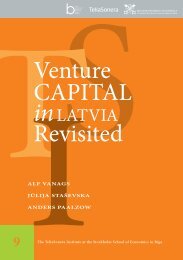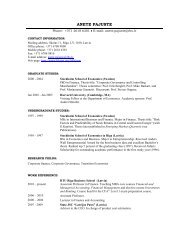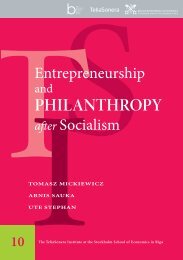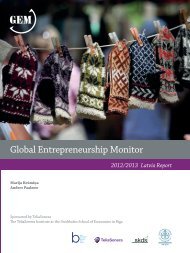A. Vanags, M. Hansen, 2005 - BICEPS
A. Vanags, M. Hansen, 2005 - BICEPS
A. Vanags, M. Hansen, 2005 - BICEPS
You also want an ePaper? Increase the reach of your titles
YUMPU automatically turns print PDFs into web optimized ePapers that Google loves.
Clearly a “quantity gap” can be observed at the bottom in Belarus where the private<br />
sector offers cheaper education to students who have failed to gain admission to the<br />
perceived elite state institutions.<br />
On the other hand a “quality gap” has not been identified anywhere at the top end of<br />
education. Rather, it seems that many institutions either compete with the public sector or<br />
offer niche education (short courses, more “practical” courses, courses for persons with<br />
older degrees) not provided by the public sector. A “human capital gap” was identified in<br />
the context of professionals/entrepreneurs as lecturers in the private sector vis-à-vis “oldstyle<br />
professors” in the public sector. An “ethnicity/language gap” was, as was to be<br />
expected, identified in Estonia and Latvia but, interestingly, may start to be reversed.<br />
Some institutions noted that many Russian-speakers now preferred more instruction in<br />
Latvian in order to better integrate – and some Latvian speakers prefer courses in Russian<br />
to improve their Russian skills and to use those in the Russian market. A “religious gap”,<br />
hitherto not mentioned, can be identified. Estonia, Latvia and Belarus have private<br />
institutions teaching theology 10 . And, as the perhaps most uniform result, we have found<br />
a strong “adaptability gap” – the public sector was simply too slow to adapt to the<br />
changes brought on by transition, thus letting the door wide open for a private sector.<br />
Finally, it was almost universally observed that the working environment – offices,<br />
lecture rooms, libraries etc – was noticeably superior at the private sector institutions than<br />
is the norm in the state sector.<br />
References<br />
Beresford-Hill, P (ed) (1998) Education and Privatization in Eastern Europe and the<br />
Baltic Republics, Triangle Books<br />
De Fraja G (2001) ‘Private and Public Schools: Theoretical Considerations’ Paper<br />
presented to the conference “Quality of Education and Labour Market Outcomes”, held<br />
in Milan on 16/17 November 2001.<br />
10 But not Lithuania. Lithuania is Catholic (whereas Estonia and Latvia are mainly Lutheran and Belarus<br />
mainly Orthodox) and we assume that theological training in such a case is firmly taken care of by the<br />
state.<br />
21






